Tucked away in the jungle of southern Belize, the ancient city of Lubaantun is a fascinating piece of Maya history with unique stone pyramids that aren’t like the usual grand Maya monuments. Instead of limestone, the buildings here are made from black slate, laid without any mortar. This clever construction style has kept Lubaantun standing, even though the city was abandoned centuries ago.
A City With No Ordinary Pyramids
Built around 730 to 890 AD, Lubaantun doesn’t have the towering, decorated temples we often picture in a Maya city. Instead, the pyramids here are shorter, with unusually rounded corners and no top temples. Archaeologists think some of these pyramids might have once held wooden structures, which have long since decayed. But what makes them really interesting is the way they’re built. Each layer of stone in these pyramids slightly sticks out over the one below it, a style called “in-and-out” masonry. This approach was rare in Maya construction and gives the site a unique look and feel.
Another odd detail? No mortar. Most of Lubaantun’s pyramids and buildings were built with dry stone construction, meaning the massive stone blocks fit together like a puzzle, without any glue holding them in place. This method required precision but has kept the buildings strong and intact for centuries.
Discovering Lubaantun: The Work of T.A. Joyce
In the 1920s, the British Museum sponsored an excavation at Lubaantun, led by archaeologist T.A. Joyce. His work helped reveal just how large and complex this city was. Joyce mapped out Lubaantun and measured the main complex to be about 900 feet long and 600 feet wide, a substantial size for a city hidden away in the jungle.
Joyce didn’t just map out the buildings; he found a treasure trove of artifacts, including pottery fragments, shell ornaments, and miniature clay figurines. These small ceramics, thought to be part of rituals, give a glimpse into the daily and spiritual life of the Maya who lived here. Curiously, Joyce found that the city was missing the usual Maya carvings—no statues or reliefs depicting gods or kings, which are usually everywhere in Maya cities. This lack of decoration has left archaeologists with more questions than answers and made Lubaantun even more intriguing.
The Crystal Skull Legend: Fact, Fiction, and Mystery
One of Lubaantun’s most famous stories is tied to the so-called “crystal skull.” The tale began in 1924 when British archaeologist Thomas Gann, who had first explored Lubaantun, invited adventurer F.A. Mitchell-Hedges to the site. True to his flair for the dramatic, Mitchell-Hedges later wrote an article claiming he had “discovered” Lubaantun, though Gann had already mapped it years earlier.
In 1925, Mitchell-Hedges returned to Lubaantun, this time as a reporter for Illustrated London News, along with Lady Richmond Brown, his companion, and his adopted daughter, Anna Mitchell-Hedges. Years later, Anna claimed that it was during this expedition that she discovered a perfectly carved crystal skull among the ruins. This skull, crafted from a single piece of quartz, became a legend, with tales of mystical powers and otherworldly origins.
However, there’s a lot about this story that doesn’t add up. First, there’s no official record of Anna even being in Belize during this expedition. Moreover, none of the official expedition reports mention a skull, and other team members denied it was ever found at Lubaantun. It wasn’t until the 1950s—decades later—that Mitchell-Hedges mentioned the skull in his writings, a surprising delay given his tendency to publicize his discoveries widely.

Stepped structure, Lubaantun Archeological Reserve, Belize. Photo by Gerry Manacsa, February 2002.
Many archaeologists believe the skull is likely a European forgery, potentially crafted in the late 19th or early 20th century, and that it bears more resemblance to Aztec-style artifacts than anything from the Maya. Paranormal believers, however, claim the skull is one of thirteen ancient artifacts that, if brought together, would supposedly heal the world. Anna Mitchell-Hedges herself claimed the skull was the key to her long life and warned that it had the power to harm those who mocked it.
Whether or not the crystal skull ever came from Lubaantun, the legend has become inseparable from the site’s identity. Even if the skull wasn’t uncovered there, the story adds an extra layer of intrigue, drawing curious travelers and keeping the city’s mysteries alive.
Exploring Lubaantun’s Unusual Pyramids Today
What sets Lubaantun apart from other Maya cities is its understated style. There are no towering temples or grand staircases here; instead, you find rounded pyramids nestled on terraces that blend naturally with the surrounding jungle. Walking through the site, it feels like stepping back in time, as Lubaantun has been left largely untouched and unaltered, giving visitors a glimpse of what it might have looked like when it was first abandoned over a thousand years ago.
Unlike popular Maya sites like Chichen Itza or Tikal, Lubaantun is peaceful and uncrowded. The stone pyramids sit quietly among dense trees, with the sounds of the rainforest filling the air. Visitors can explore freely, moving at their own pace to take in the unique architecture and details of this ancient city.
Why Lubaantun’s Pyramids Matter
Lubaantun’s pyramids may be small, but they’re an important piece of Maya history. Their unusual construction style, the dry stone technique, and the choice to build with black slate show how adaptable and resourceful the Maya were. The design might seem simple, but it required an impressive amount of skill and planning to build structures that have survived so long.
What’s more, Lubaantun’s lack of carved decorations and typical Maya artwork makes it stand out from other Maya sites. Archaeologists still aren’t sure why it’s so different, but it’s part of what makes Lubaantun fascinating. To me, this tells us that the Maya weren’t a single culture with identical practices; they were a diverse civilization, each city shaped by its resources, beliefs, and leaders.
To sum it up? Lubaantun is worth a visit if you ask me. Its stone pyramids and terraces offer a unique look at Maya life without the tourist crowds and towering monuments found elsewhere (as is typical for such sites in Belize and other parts of Central America. So, whether you’re drawn by the mystery of the crystal skull or the charm of its unique pyramids, Lubaantun has something special to offer. It’s a piece of ancient history, hidden in Belize’s rainforest, waiting to be explored. As with all my pother articles on myramids, the location of this parituclar site is shown in the map here below.

